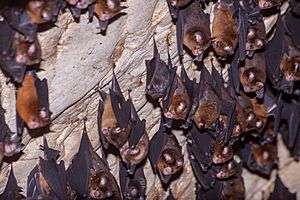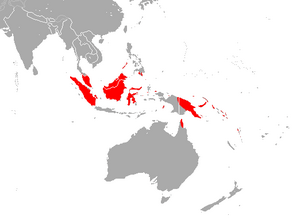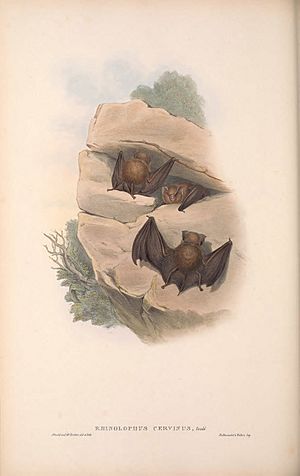Fawn leaf-nosed bat facts for kids
Quick facts for kids Fawn leaf-nosed bat |
|
|---|---|
 |
|
| Scientific classification | |
| Genus: |
Hipposideros
|
| Species: |
cervinus
|
 |
|
| Fawn roundleaf bat range | |
The fawn leaf-nosed bat (scientific name: Hipposideros cervinus) is a type of bat. You can find these bats in countries like Australia, Indonesia, Malaysia, the Philippines, and Vanuatu. They are known for their unique nose shape.
Contents
About the Fawn Leaf-Nosed Bat
Naming and Classification
Scientists give animals special names to help identify them. The fawn leaf-nosed bat was first described by a scientist named John Gould in 1854. He wrote about it in his book, The Mammals of Australia.
This bat has several common names. People also call it the fawn roundleaf bat, fawn-colored leaf-nosed bat, or Gould's leaf-nosed bat.
Scientists have found that there are a few different types, or subspecies, of the fawn leaf-nosed bat. These include:
- Hipposideros cervinus batchianus
- Hipposideros cervinus cervinus (this is the original type found in Australia)
- Hipposideros cervinus labuanensis
- Hipposideros cervinus misorensis
Physical Description
The fawn leaf-nosed bat is a medium-sized bat. It has a special nose structure called a "nose-leaf." This nose-leaf helps the bat with echolocation, which is how bats "see" using sound. The nose-leaf is usually greyish pink and has a squarish shape. It has small leaf-like parts on its sides.
The bat's ears are shaped like triangles and come to a point at the tip.
When they are young, called pups, these bats are dark gray. As they grow into adults, their fur turns dark brown. Sometimes, their fur can even become a bright orange color. This happens because of chemicals from their droppings in the places where they sleep.
Here are some typical measurements for the fawn leaf-nosed bat:
- Its forearm length is about 45–48 millimeters (about 1.7 to 1.9 inches).
- Its head and body together are about 41–51 millimeters long (about 1.6 to 2 inches).
- Its ears are about 13–15 millimeters long (about 0.5 to 0.6 inches).
- An average bat weighs about 7 grams (about 0.25 ounces).
Where They Live
The fawn leaf-nosed bat lives in a wide area. This includes the Malay Peninsula and many islands in Indonesia and New Guinea. They can be found from sea level up to 1400 meters (about 4,600 feet) high in the mountains.
In Australia, they are found on islands in the Torres Strait, which is northeast of the mainland. They have also been seen a few times on the mainland, near Cape York and the town of Coen, Queensland.
Life and Habits
Roosting and Foraging
These bats like to live in groups. They often sleep, or "roost," in caves and old mines. They hang separately from each other, not in big huddles. Sometimes, they share their roosts with other types of bats. In 1958, scientists estimated that about 250,000 of these bats lived in Niah National Park!
Fawn leaf-nosed bats hunt for food in many different places. They can be found in thick rainforests or open woodlands.
They mainly eat mid-sized insects like beetles and moths. They catch these insects while flying close to plants, over water, or near the ground. They are slow flyers but can turn very quickly. This helps them catch their prey easily. They are sometimes seen hunting in small groups.
Reproduction and Life Cycle
Fawn leaf-nosed bats usually have one baby at a time. This birth happens between November and December.
When they are very young, baby bats cling to their mother's belly. They stay in this position whether the mother is sleeping or flying. When it's time to feed, the baby bat turns around to get food from its mother.
Conservation Status
In 2008, the IUCN (a group that checks on animals) said the fawn leaf-nosed bat was of "least concern." This means there are many of them, and they are spread out over a large area. They can also handle some changes to their environment.
However, scientists are worried about large areas of forest being cut down where these bats live. Even though we don't know exactly how their numbers are changing, this could be a problem for them.
In the Australian state of Queensland, the fawn leaf-nosed bat is listed as "vulnerable to extinction." This means they are at risk of disappearing there. They used to be found in Singapore, but they might not live there anymore.


